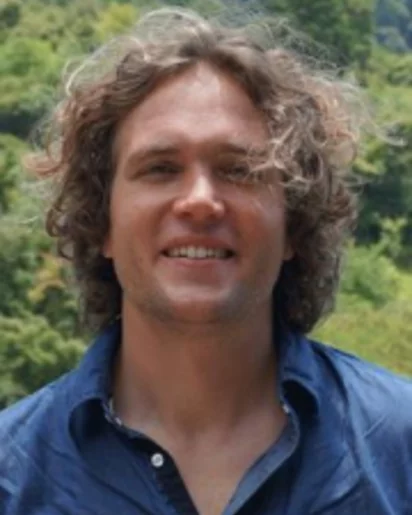Professorships
Biography
After initially studying philosophy at Radford University in Virginia, Hugo Dil finished his studies in physics at the Technical University of Delft. During his master thesis he started using synchrotron radiation for electronic structure measurements and combined this with LEED-IV studies for structural information. Hugo did a PhD at the Fritz Haber Institute and Freie Universität in Berlin on the electronically driven self-organised growth of nanostructures as studied by ARPES, working at the Bessy synchrotron and the Advanced Light Source in Berkeley. Afterwards he moved to the University of Zurich and the Swiss Light Source where he became subgroup leader responsible for the spin- and angle-resolved photoemission (SARPES) end station COPHEE. From 2013 to 2019 he held a SNSF funded professorship at the Institute of Physics at the Ecole Polytechnique Fédérale de Lausanne, while maintaining the connection to the Paul Scherrer Institut. In 2014 he was awarded the Heinrich Rohrer Rising Medal by the Surface Science Society of Japan (SSSJ) for his leading and creative roles in identifying novel spin structures using synchrotron radiation-based SARPES. In 2015 he received the University Latsis Prize for his work on topological insulators and for the identification of spin interference. Hugo serves at several proposal review committees at other synchrotron facilities and is an active reviewer for international funding proposals and various top level scientific journals. Further he teaches at the EPFL and international doctoral schools, including the well known Hercules school organised in Grenoble.
Institutional Responsibilities
Hugo Dil is responsible for the spin- and angle-resolved photoemission spectroscopy (SARPES) activities at the Swiss Light Source. Besides managing the COPHEE end station this also includes the development of novel spin detectors.
Scientific Research
Hugo Dil’s experimental research interest focuses on how reduced dimensionality and symmetry influence the spin properties of materials. Prominent examples of this are the Rashba effect at surfaces and interfaces and the surface spin textures imposed by the band topology of the bulk states. More recent examples are the symmetry breaking in polar and ferroelectric materials and the bulk spin textures that results from this, also in combination with magnetic order and their coupling in multiferroic materials. Recent interests also include the determination of the time scale of fundamental quantum mechanical processes and even the question of the nature of time. Hugo has published three review articles on these topics.
Selected Publications
For an extensive overview we kindly refer you to our publication repository DORA.
Operando imaging of all-electric spin texture manipulation in ferroelectric and multiferroic Rashba semiconductors, J. Krempasky, S. Muff, J. Minar , N. Pilet, M. Fanciulli, A.P. Weber, E.B. Guedes, M. Caputo, E. Mueller, V.V. Volobuiev, M. Gmitra, C.A.F. Vaz, V. Scagnoli, G. Springholz, J.H. Dil, Physical Review X 8, 021067 (2018).
We managed for the first time to observe the operando switching of the spin texture of a ferroelectric and even multiferroic material. The idea is rather simple; if the ferroelectric polarisation is reversed, then also the structural inversion symmetry breaking in reversed, and thus the axis relevant for the Rashba-type spin splitting of the bulk bands is inverted and the spin helicity changes sign. For a multiferroic material with strong magnetoelectric coupling the reversal of ferroelectric polarisation will also reverse the magnetisation direction. Both spin textures can be measured by SARPES, but the difficulty is to apply an electric field during these surface sensitive measurements in UHV. We took a blunt, and risky, approach of placing a gold mesh on top of the thin film sample, which allowed us to still clean the surface and to measure it by SARPES. Although difficult, this approach worked and we could observe the reversal of the spin helicity and magnetisation direction.
Spin-Resolved Electronic Response to the Phase Transition in MoTe2, Andrew P. Weber, Philipp Rüßmann, Nan Xu, Stefan Muff, Mauro Fanciulli, Arnaud Magrez, Philippe Bugnon, Helmuth Berger, Nicholas C. Plumb, Ming Shi, Stefan Blügel, Phivos Mavropoulos, J. Hugo Dil, Physical Review Letters 121, 156401 (2018).
When passing through the phase transition at 250K the crystal structure of MoTe2 breaks the space inversion symmetry. This change has important consequences for the material being a Weyl semimetal, but the change in the electronic structure is only very small and hard to resolve by ARPES. However, the spin texture of the bulk states changes dramatically and this can be directly measured by SARPES. Furthermore, it is found that above the transition temperature the surface region of the material is dynamical phase with polar fluctuations.
Spin polarization and attosecond time delay in photoemission from spin degenerate states of solids, Mauro Fanciulli, Henrieta Volfová, Stefan Muff, Jürgen Braun, Hubert Ebert, Jan Minár, Ulrich Heinzmann, J. Hugo Dil, Physical Review Letters 118, 067402 (2017).
We developed and applied a new method to measure the ultrashort (attosecond) time scale of the photoemission process. It relies on the relationship between time and phase shift, and phase shift and spin as measured by SARPES and it does not require any ultrashort laser pulses. The technique is complimentary to other approaches such as attosecond streaking, and in contrast to such methods it is actually capable to determine the absolute time scale and not only a relative time delay. We applied the method to the spin degenerate bulk sp-band of copper and obtained a time delay of 26 attosecond.
Observation of correlated spin–orbit order in a strongly anisotropic quantum wire system, C. Brand, H. Pfnür, G. Landolt, S. Muff, J.H. Dil, T. Das, Ch. Tegenkamp, Nature Communications 6, 8118 (2015).
The electronic structure of Pb nanowires grown on vicinal Si(111) looks two-dimensional and shows almost no dependency on the exact amount of Pb or temperature. However, for an optimal coverage and below a transition temperature of about 80K the transport properties become highly anisotropic with the system being metallic along the wires and insulating perpendicular to them. Based on the measured spin texture and its dependency on the exact Pb coverage this can be explained by the formation of a spin-orbit density wave (SODW), which is a dynamical nesting of spin polarised states at the Fermi level. Additional charges decohere this state and restore normal conductivity.
Review Articles
The following three review articles give an overview of the state-of-the-art of SARPES research and provide an idea of the possibilities and limitations of the technique.
Spin- and angle-resolved photoemission on topological materials, J. Hugo Dil, Electronic Structure 1 023001 (2019).
Spin–orbit-induced photoelectron spin polarization in angle-resolved photoemission from both atomic and condensed matter targets, U. Heinzmann and J.H. Dil, Journal of Physics: Condensed Matter 24, 173001 (2012).
Spin and angle resolved photoemission on non-magnetic low-dimensional systems,
J. Hugo Dil, Journal of Physics: Condensed Matter 21, 403001 (2009).


